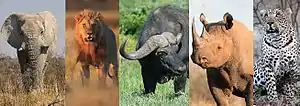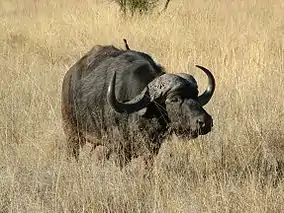Big five game
In Africa, the Big Five game animals are the lion, leopard, rhinoceros (both south-central black and southern white species), elephant, and Cape buffalo.[1] The term was coined by big-game hunters, and refers to the five most difficult animals in Africa to hunt on foot,[2][3][4] but is now also widely used by safari tour operators.[5][2][6]


The 1990 and later releases of South African rand banknotes feature a different big-five animal on each denomination.
Each of the big five are examples of charismatic megafauna, featuring prominently in popular culture, and are among the most famous of Africa's large animals.
Countries where all can be found include Angola, Botswana, Zambia, Uganda, Namibia, South Africa, Kenya, Tanzania, Zimbabwe, the Democratic Republic of the Congo, Rwanda and Malawi.[7][8]
Species
African elephant

The African elephant (Loxodonta africana) is a very large herbivore having thick, almost hairless skin, a long, flexible, prehensile trunk, upper incisors forming long curved tusks of ivory, and large, fan-shaped ears. The two distinct species of African elephant are: African forest elephant (Loxodonta cyclotis) and the African bush elephant (Loxodonta africana).They become aggressive when their young ones are being maltreated or their view of their young is being blocked. Elephants are difficult to hunt because, despite their large size, they are able to hide in tall grass and are more likely to charge than the other species.[9]
Black rhinoceros

The black rhinoceros (Diceros bicornis) is a large herbivore having two upright horns on the nasal bridge. Its thick (1.5–5 cm) protective skin, formed from layers of collagen positioned in a lattice structure, is very hard to puncture. It is now critically endangered, and hunting is extremely limited due to this. In the context of big-game hunting in Africa, the term "rhinoceros" may also refer to the white rhinoceros, but among big five game hunters, the black rhinoceros is preferred.[10]
Cape buffalo

The African buffalo or Cape buffalo (Syncerus caffer) is a large horned bovid. They are the only animals within the Big Five that are not endangered or threatened.[11] The Cape buffalo is considered by many to be the most dangerous of the big five to hunters,[12] with wounded animals reported to ambush and attack pursuers.[13]
African lion

The lion (Panthera leo) is a large feline of Africa and northwest India, having a short, tawny coat, a tufted tail, and in the male, a heavy mane around the neck and shoulders. Lions are desirable to hunters because of the very real danger involved in hunting them.[14] [15][16]
African leopard

The African leopard (Panthera pardus pardus) is a large, carnivorous feline having either tawny fur with dark rosette-like markings or black fur. The leopard is considered the most difficult of the big five to hunt because of their nocturnal and secretive nature. They are wary of humans and will take flight in the face of danger. The leopard is solitary by nature, and is most active between sunset and sunrise, although it may hunt during the day in some areas. Leopards can be found in the savanna grasslands, brush land and forested areas in Africa. Of the big five, it is most difficult to acquire hunting as well as the licenses for.[17]
Conservation status
Africa's Big Five have become major concerns for wildlife conservationists in recent years. The African lion, African leopard and African bush elephant are all classified as vulnerable. The southern white rhinoceros is classified as near threatened while the black rhinoceros is classified as critically endangered, so hunting them is greatly restricted.[18] The African buffalo is the most popular big five game animal to hunt, as its conservation status is least concern, but it is experiencing a population decline in uncontrolled areas due to poaching and urbanization.
See also
References
- Capstick, Peter H. (1984). Safari, the last adventure. St. Martin's Press. p. 148. ISBN 978-0-312-69657-3.
Generally known as the "Big Five," the group we're talking about comprises lion, leopard, elephant, Cape buffalo and rhino, although not necessarily in that order.
- Zijlma, Anouk. "The Big Five: Index". Africa for Visitors. About.com. Archived from the original on 9 February 2007. Retrieved 29 December 2006.
- Capstick, Peter H. (1983). Death in the Dark Continent. St. Martin's Press. p. 13. ISBN 978-0-312-18615-9.
No human being could begin to outrun any of the big five, nor would he last more than a few seconds in any contest of strength.
- Du Toit, Richard (2001). Africa's Big Five. Struik Publishers. ISBN 978-1-86872-582-3.
- "Understanding and Protecting the Big Five in South Africa". goeco.org. Retrieved 14 December 2018.
- Nelson, Marsea. "Ten Wild Facts about the "Big Five"". www.worldwildlife.org. worldwildlife.org. Retrieved 14 December 2018.
- Planet, Lonely (28 October 2013). "Lonely Planet's Best in Travel 2014 - top 10 countries". lonelyplanet.com.
- "Rhinos Return to Rwanda's Akagera National Park after 10 Years". ugandatravelblog.com. 2 May 2017. Archived from the original on 20 July 2018. Retrieved 2 May 2017.
- Fodor's African Safari, 1st Edition: From Budget to Big Spending Where and How to Find the Best Big Game Adventure in Southern and Eastern Africa. Fodor's. 2004. p. 142. ISBN 978-1-4000-1234-3.
- "Current Zoology" (PDF).
- Stumpf, Bruce G. "Africa on the Matrix: The Cape Buffalo". Archived from the original on 20 December 2002. Retrieved 23 October 2010.
- Wieland, Terry (2006). Dangerous-Game Rifles. Countrysport Press. p. 286. ISBN 978-0-89272-691-2.
- "African Animals Hunting facts and tips - Buffalo Hunting". safariBwana newsletter. Archived from the original on 8 July 2013. Retrieved 23 October 2010.
- Capstick, Peter H. (1984). Safari, the last adventure. St. Martin's Press. p. 165. ISBN 978-0-312-69657-3.
- "African Lion". safaribwana.com. Archived from the original on 16 April 2016. Retrieved 1 October 2010.
- Robinson, Steve (2008). "Unpleasant Truth About Canned Shooting". shakariconnection.com. Shakari Connection. Retrieved 2 October 2010.
- "News - Meet The Big Five". www.holidaytourafrica.com. Retrieved 19 January 2021.
- "Diceros bicornis".
External links
| Look up big game in Wiktionary, the free dictionary. |